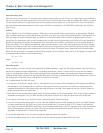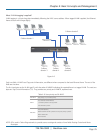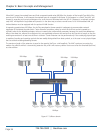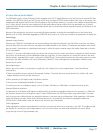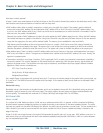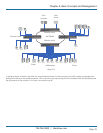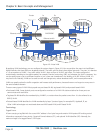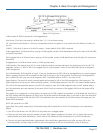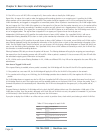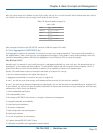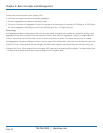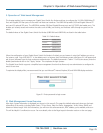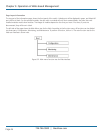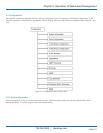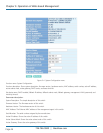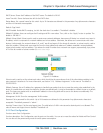
724-746-5500 | blackbox.com
Page 42
Chapter 4: Basic Concepts and Management
2. If the VID is not a null VID (VID is not equal to 0), then use the value to classify the VLAN group.
Egress Rule: An egress list is used to make the tagging and forwarding decision on an outgoing port. It specifies the VLANs
whose packets can be transmitted out and specifies if the packet should be tagged or not. It can be configured for the port’s
VLAN membership, and tagged or untagged for a transmitted packet. When a packet is transmitted out, the VLAN bridge checks
the port’s egress list. If the VLAN of the packet is on the egress list of the port that the packet transmits out on, the packet will be
transmitted with the priority accordingly. If enabled, an egress port will transmit out a tagged packet if the port is connected to a
802.1Q-compliant device. If an egress port is connected to a non-802.1Q device or an end station, the VLAN bridge must transmit
out an untagged packet. The tag has been stripped off in an egress port. Egress rule can be set by per port.
Independent VLAN Learning (IVL) specifies the mode chosen to learn a MAC address. For a specified VLAN, it will use an
independent filtering database (FID) to learn or look up the membership information of the VLAN and decide where to go.
Shared VLAN Learning (SVL) specifies the mode chosen to learn a MAC address. In this mode, some VLANs or all VLANs use the
same filtering database storing the membership information of the VLAN to learn or look up the membership information of the
VLAN. For the Gigabit Smart Switch Eco Fanless, you can choose a VID for sharing a filtering database in a Shared VID field if you
want to use the existing filtering database. For a specified VLAN, when a MAC address is learned by a switch, the VLAN will use
this formation to make forwarding decisions.
Filtering Database (FID) tells you where the packet will be sent. The filtering database will supply the outgoing port according to
the request from the forwarding process with VID and DA. When a packet is received, if it has a non-zero VID, then FID will offer
the associated outgoing ports information to the packet.
In SVL, VLANs use the same Filtering Database. In IVL, VLANs use different FIDs. Any VID can be assigned to the same FID by the
administrator.
How does a Tagged VLAN work?
If the ingress filtering is enabled, when a packet is received, the VLAN bridge will first check if the VID of the packet presents.
1. If the packet has a non-zero VID, the VLAN bridge will apply this VID as the VLAN ID of the packet in the network.
2. For a packet with null tag or no VLAN tag, the VLAN bridge provides rules to decide its VID, then applies this VID to the
packet.
If a VLAN bridge does not support any rule for VID, then it applies the PVID of the port to the packet that came from that port.
A LAN bridge checks to see if the ingress port and the received packet are on the same VLAN. If not, it drops the packet. If yes, it
forwards the packet to the associated ports. Meanwhile, this VLAN must be applied to the egress port, or the packet will be
dropped.
If ingress filtering is disabled, a VLAN bridge will only check the MAC address table to see if the destination VLAN exists. If the
VLAN does not exist, then the packet is dropped, and if both DA and VLAN do not exist, the packet is forwarded. If it just knows
a VLAN existed, it then floods the packet to all the ports the VLAN covers.
If you plan to deploy four VLANs in an office and use a switch to partition them, check which ports belong to which VLAN first.
Table 4-7. Ports assigned to each VLAN.
Name VID Port Members
Marketing 2 1, 2, 3, 4, 5
Service 3 6, 7, 20, 21, 22
Sales 4 8, 9, 10, 11, 12, 13, 14, 15, 16
Administration 1 17, 18, 19, 23, 24



